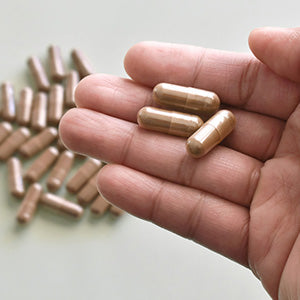The 5 Worst Things About Flame Retardants

Not long ago, I discussed 12 ways toxins are sneaking into your life, and while I briefly mentioned the health dangers of flame-retardants, that was just the tip of the iceberg. There’s been a lot of talk lately about these chemicals: namely, that they don’t work as well as claimed. There’s even data suggesting that items treated with flame retardants and those untreated tend to burn at the same rate. So what benefits, if any, are these chemicals providing for us? [1] Well, they’re certainly not helping, and here are 5 ways they're causing harm.
Flame Retardant Facts You Need to Know
1. Flame Retardants Cause Cancer
For years, studies have suggested that flame retardant chemicals contribute to cancer. The most recent study in October 2014 tested healthy Americans for the presence of six chemicals. Flame retardant toxins were found in the blood and urine of all the subjects. [2] One of the toxins, TCEP, has never even been seen in the US! Another, chlorinated tris, was once used to treat pajamas. Evidence emerged in the 1970s linking it to DNA mutations and cancer, so it was removed from the pajamas. Unfortunately, it is still used to treat furniture foam and many of us remain exposed.
2. Flame Retardants Contaminate the Environment
Like most pollutants, once flame-retardants are in the environment, they tend to stay there. They’re even getting into the bodies of certain gulls. Since these birds aren’t eating furniture, what's the source? In this case, it’s contaminated fish. So how then are those fish becoming toxic? The answer points to one unlikely source – laundry. Flame retardants are sneaky in that they tend to travel around in dust. [3] Dust gets on clothes, clothes are washed, and the water from the laundry machine becomes runoff, eventually filtering into our ecosystem. A recent study actually looked at laundry waste water samples and found 18 different flame-retardants.
3. Furniture is a Huge Point of Exposure
A Duke University study looked at the urine samples of 22 women and 26 children and found evidence of exposure to the flame retardant TDCPP in all of them; another found that 85% of couch cushions contain some form of flame retardant. [4] [5] As the most common application is mattress foam, sofas, pillows, and carpet padding, it’s not really a question of if you will be exposed, but when. Currently, only California requires products containing TDCPP and other flame-retardants to have warning labels. Here’s hoping other states follow suit.
4. Flame Retardants Encourage Obesity
Introduced in 2003, Firemaster 550 (FM550) was originally meant to serve as an alternative for the toxic pentabromodiphenyl ether. There’s recent evidence, however, that exposure to this flame retardant not only contributes to fat production, but also speeds up bone loss. [6] Remember how I mentioned that flame-retardants often travel in dust? Well, these dust-borne toxins can be inhaled at an alarming rate. In addition to hormone disruption and cancer risk, FM550 also brings the threat of obesity and osteoporosis.
5. Flame Retardants are Linked to Leukemia
All flame-retardants can be toxic to your health, but I want to focus on one more group – polybrominated diphenyl ethers, or PBDEs. PBDEs are no longer made or used in the US due to an increased risk of liver, thyroid, and neuro-developmental issues; however, they can still be found in imported products or older US-manufactured products. As with all flame-retardants, PBDE persists in the environment as well. Clearly, PBDE is a lingering threat, and rightly so. In addition to the health concerns connected to these chemicals, a recent study even suggests a link to leukemia. [7]
One Final Thought
References (7)
- Natural Resources Defense Council. Toxic Chemicals in our Couches. NRDC Fact Sheet.
- Silent Spring Institute. A Previously Unrecognized Flame Retardant Found in Americans for the First Time. Silent Spring Institute
- Schreder, E. Flame Retardant Transfers from U.S. Households (Dust and Laundry Wastewater) to the Aquatic Environment.. Environmental Science & Technology 48 (19), 11575-11583.
- Stapleton, H. et al. Metabolites of Organophosphate Flame Retardants and 2-Ethylhexyl Tetrabromobenzoate in Urine from Paired Mothers and Toddlers.. Environmental Science & Technology 48 (17), 10432-10438.
- Stapleton, H. et al. Novel and High Volume Use Flame Retardants in US Couches Reflective of the 2005 PentaBDE Phase Out.. Environmental Science & Technology 46 (24), 13432-13439.
- Wendee, N. More Fat, Less Bone? Environmental Health Perspectives. 122 (11).
- Tillett, T. Zeroing In on a Risk Factor? PBDE Exposure and Acute Lymphoblastic Leukemia. Environmental Health Perspectives. 122 (10).
†Results may vary. Information and statements made are for education purposes and are not intended to replace the advice of your doctor. If you have a severe medical condition or health concern, see your physician.

Dr. Edward Group, DC
FOUNDER | HEALER | ADVOCATEDr. Group, DC is a healer and alternative health advocate, and an industry leader and innovator in the field of natural health who is dedicated to helping others. He is a registered doctor of chiropractic (DC), a naturopathic practitioner (NP), and proud alum of Harvard Business School and MIT Sloan School of Management. Dr. Group, DC is the founder of Global Healing – a mission and vision he has shared through best-selling books and frequent media appearances. He aims to spread his message of positivity, hope, and wellness throughout the world.










